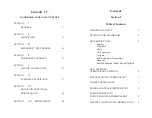
Monticello Flying Club Pilot Transition Manual: Mooney M20F
Page 30 of 42
Remove all personal belongings and trash from the airplane. Aim to leave the airplane in
better shape than you found it. A little bit of effort goes a long way in terms of keeping the plane
in good shape.
Refuel the airplane per club policy (fill both tanks to 1 inch below the top). Complete the
flight-log. Notify the club maintenance officer if any anomalies or squawks need to be reported.
W
INTER
O
PERATIONS
Operations are the same as done with most aircraft. The engine will generally require
more priming during cold weather operations, so allow the fuel pump to run a little longer during
priming.
There is an oil sump heater on this aircraft with the plug tied to the oil filler neck and
during the winter there will be an extension cord in the back of the plane.
When the field
temperature is below 32
o
F, plug in the sump heater into a plug outlet an hour prior to engine
start.
While using the sump heater, leave the cowl plugs in and place the folded over aircraft
cover over top of the cowl to help trap the heat in the engine compartment. Alternatively, the
engine may be pre-heated using blown pre-heat air. Consult the club aircraft use rules for more
details.
Once started, reduce engine RPM and let the engine warm up on the ramp prior to
moving to the run-up area. Monitor the oil temperature closely. Cold weather operation can be
hard on an engine, so we need to do whatever we can to minimize wear.
Install the cowl plugs soon after shut down to allow for gradual cooling.
As with all
aircraft, do not take off with visible frost or ice on the wings.
During the winter a brush will be in
the plane for brushing off snow and frost.
Be gentle on the paint job and
never, ever scrape ice
off of the windshield or surfaces
.
If there is ice on the wings/windshield, you can ask the FBO
to move the plane into their hanger for heating. It takes about a half hour to melt moderate ice in
the hanger.
Make sure to dry up any water around the control surfaces so that it doesn’t refreeze
and prevent control movement.
Finally, occasionally check (particularly while using cabin heat) the carbon monoxide
detector on the panel to make sure carbon monoxide is not entering the cabin.
N
IGHT
O
PERATIONS
For night operations, make sure to check all lights during preflight. The knobs on the
ceiling control the panel and red (spot) lights. One knob controls the panel lights, and the other
controls the red lights (this configuration may seem counter-intuitive at first). The dimmer knob
will get hot; this is normal.
O
PERATING THE I
P
AD AND
S
TRATUS
2
The club has installed these items to improve situational awareness, but again, they are
not allowed for use as primary flight instruments. Additionally, it is critical that you not allow
these to distract you from your primary responsibility of operating the aircraft. There are many
videos on how to best operate this equipment on YouTube and the manuals can be found on the
Club’s aircraft page and in the iPad Foreflight program.
The best way to prevent these from
distracting you is to become thoroughly proficient with them prior to operating them in flight.
Both items are plugged in via USB cable to the lighter adapter splitter under the panel on the
pilot’s side. They should always be plugged in during flight and unplugged after flight.












































